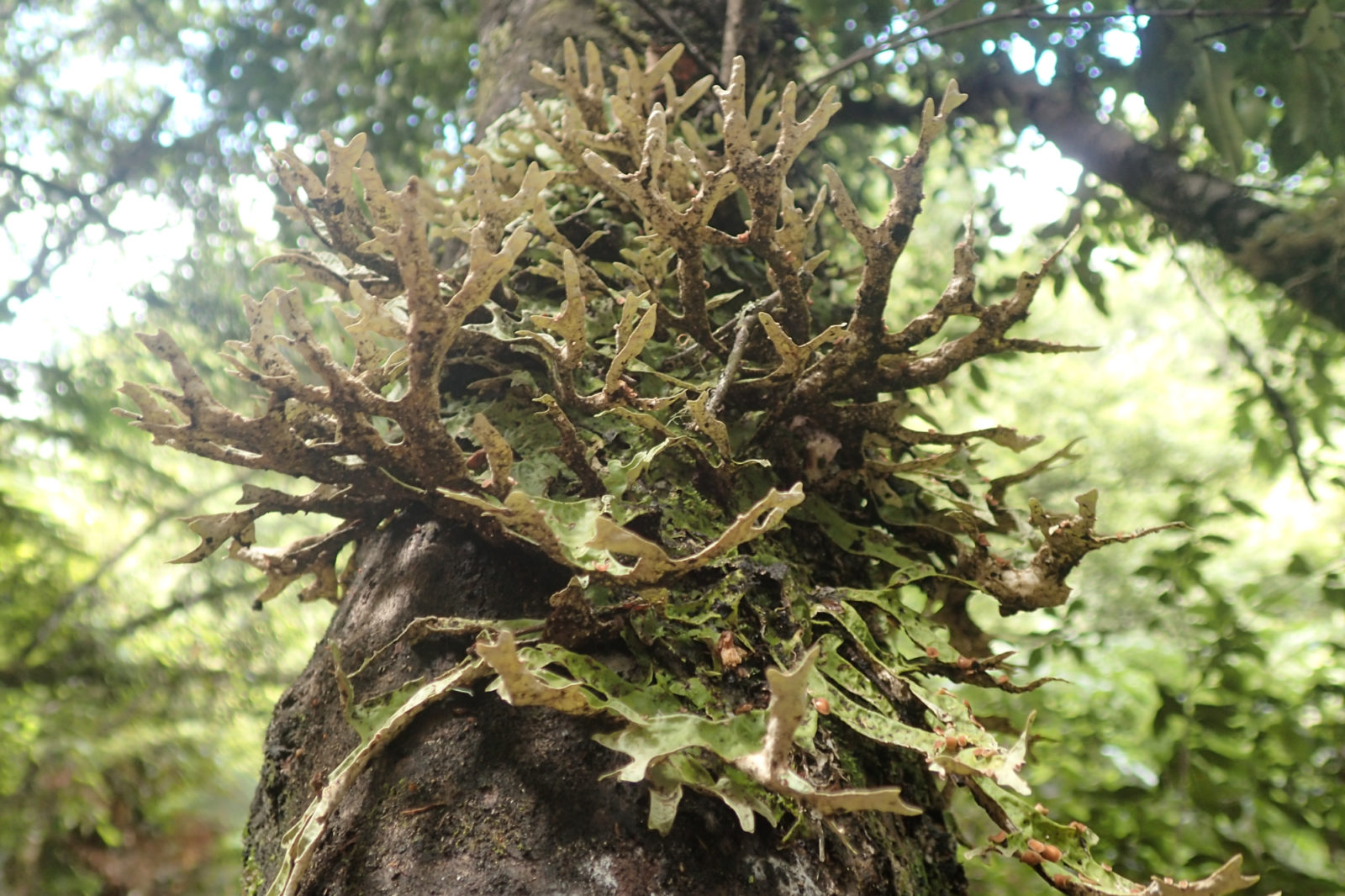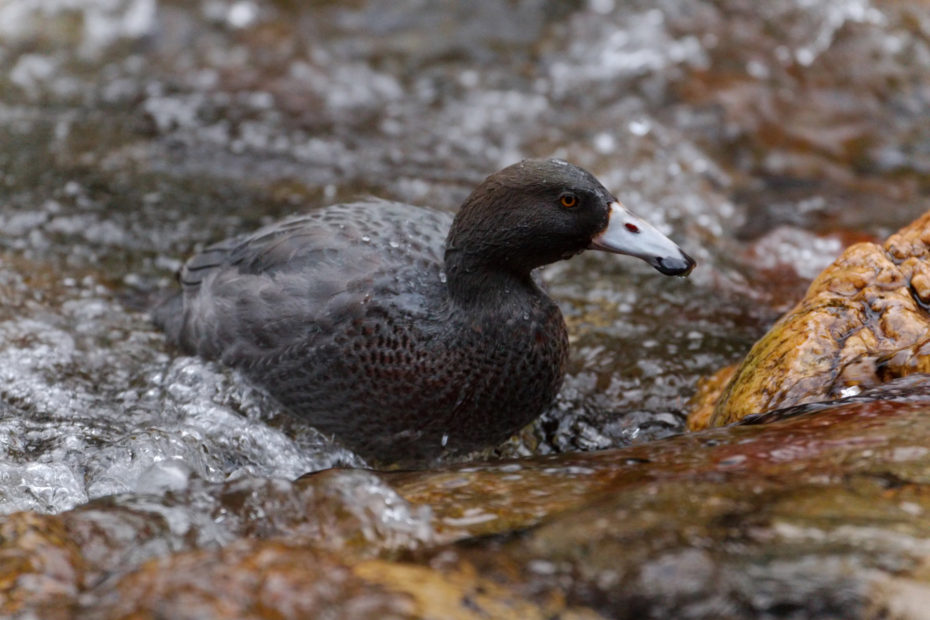The tail of a cyclone was headed our way with heavy rain forecast. This was inconvenient as we were starting a three-day hike in the Whirinaki forest tomorrow. The Whirinaki is only two hours southeast of Rotorua on New Zealand’s north island, but to describe the area as off-the-beaten-track would be an understatement – we had possibly travelled backwards through time to the 80s. We were staying in a rustic lodge on the forest edge, a collection of funny little rooms attached to the main house plus a few demountable trailers and assorted piles of rusting junk in the yard. It seemed designed expressly to induce paranoia in a person who had just binge-watched the entire series of Making a Murderer. Our room came replete with wallpaper, floral curtains and a stuffed albino possum mounted outside the door. Luckily, our host Gary seemed more like a friendly but socially-awkward hobbit than a psychopath.
Gary drove us to the start of the hike in our car the next morning, refusing to wear a seatbelt so that the car beeped frantically for a good ten minutes. Maybe he was a little odd. As we entered the car park we were suddenly steeped in the shade of Jurassic-looking trees. On cue, the rain started to pour, and we put on our packs with a grim sense of fatalism. Gary waved goodbye smugly from our lovely dry car and disappeared, carrying all of our valuables back to the lodge where they would hopefully be safe from the destructive impulses of bored local youths.
Being wet for three days in a row now seemed inevitable, and the idea didn’t fill me with joy. But rain or not, I was excited. We were hoping to glimpse the Whio – a Maori name pronounced ‘fee-oh’ – an endangered and beloved blue duck, unique because it has evolved in isolation from all other ducks, geese and swans. They live the fast life, spending all their time on swift-flowing rivers – one of only a handful of waterfowl species worldwide to do so.
But the Whio have been ravaged by feral possums, dogs and cats – and most of all by cunning stoats who raid their riverside nests and eat the eggs. New Zealand’s thriving hydropower industry has also tamed many wild rivers, destroying the fast-flowing habitat that the Whio need. There are now only 2,500 or less left. Luckily the Kiwis take conservation very seriously, and have been waging an all-out war on stoats in the Whirinaki – as a result it is one of the few places where you have a decent chance of seeing Whio in the wild. Seeing them, I reasoned, would make being wet worthwhile.
Setting off, the cloth-like quiet of the podocarp forest enveloped us immediately. As we walked, we heard only our boots on the ground and the occasional call of a hidden bird. The forest was extraordinary, carpeted in strange plant forms. Hundreds of tiny silver spheres balanced in the claws of a shaggy moss. A family of delicate orange mushrooms emerging shyly from the forest floor. Tree ferns lit up like spiralled mosaics under a lonely beam of sunlight. We stopped constantly to wonder at the exquisite detail and take hundreds of macro photos.
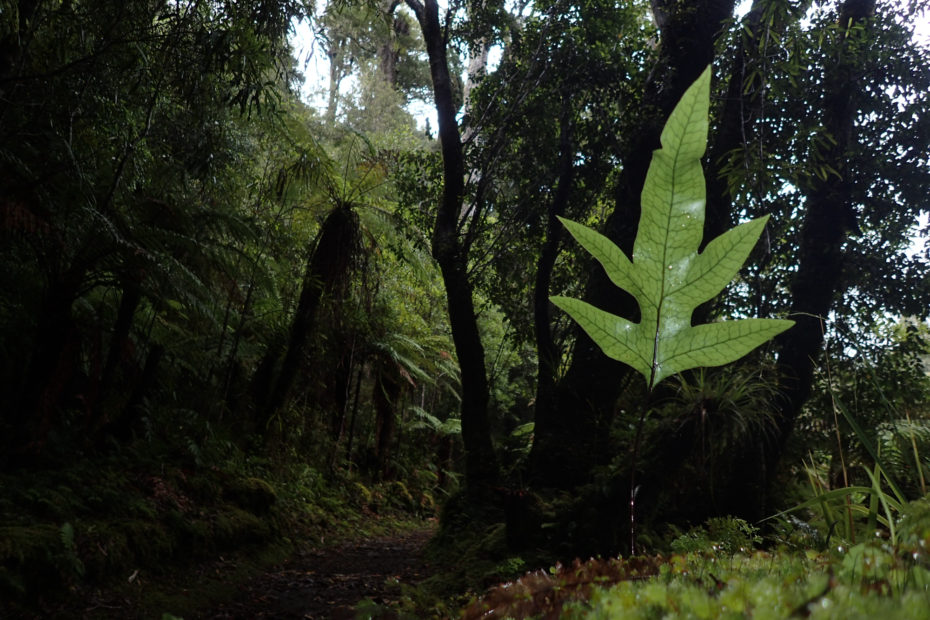
A forest view being photobombed by a falling leaf.
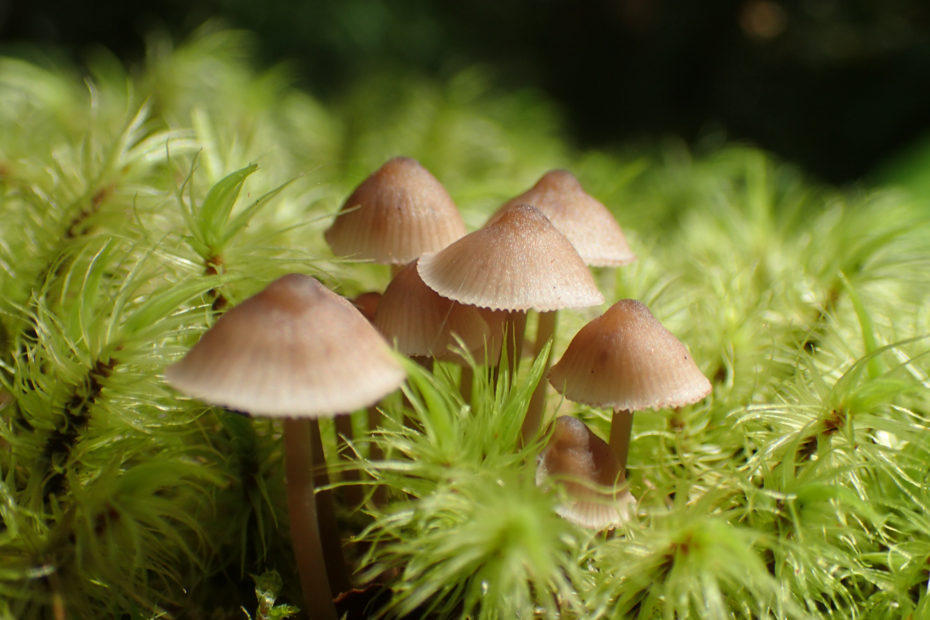
Mushrooms in the moss.
After a couple of hours we met with the Whirinaki river, climbing uphill and back down again as we followed its bends. The rain continued to slosh down from a sky of wet cotton balls and the force of the river was pushing white water all the way up into the banks. We hurried past landslides that seemed to have just happened, where exposed walls of earth towered precariously above us.
Our constant stops to marvel at things had seriously slowed us down, and five hours into a supposed 4.5 hour walk we were still a fair way from Central Hut, where we planned to spend the night. I committed the classic error of taking my raincoat off because I was too hot. Very soon I was feeling very wet and very cold. I had no energy left and my back was hurting. Soldiering on through the rain, the words from the national park pamphlet taunted me – ‘It is a relatively easy trip suitable for people of low to moderate fitness’.
Then, from the deep gloom of the late afternoon we heard a strange whistle, like a wind-vane swinging. Right there in the raging rapids was a pair of Whio – the endangered blue duck – only a couple of metres from us. Elated, we crouched down and watched, mesmerised as they manoeuvred with graceful ease in the seething currents.
The male’s eerie whistle rose above the roar of the river, and the female replied with a low guttural whir. If I’d seen these birds static, in a photograph, I might have said they were quite nice for ducks, but nothing to write home about. In real life they were captivating. Their slate-blue feathers had a subtle glow in the strange dusk-light. Their visible adaptation to this seemingly unlivable niche was incredible. Their precise movements and complex interactions imbued them with an intelligence – and the bond between the two birds was palpable.
When we finally arrived at Central Hut, I was physically exhausted but spiritually buoyed by our blue duck sighting. I peeled off my wet clothes and encased my body in thermals. We were reasonably high up in the mountains now, and it was getting cold as the sun sank. We had the hut, which contained 24 bunks, all to ourselves. This was the moment we realised we had forgotten a lighter and had no way to build a fire, or even more crucially, cook our food. Was it better to eat cold and uncooked instant lamb stew? Would adding cold water to instant potato mash make it safe to eat? Or was it better to simply go without?
As it was a semi-survival situation we felt justified in rummaging about in the plastic storage boxes containing supplies for rangers and wardens. We were unimpeachably honest, and did not lay a finger on their snickers bars. Simon removed a nine-volt battery from a torch and claimed, to my incredulity, that if we could find some steel wool the combination of these two seemingly-random items would create fire.
In his element, Simon soon had a fire crackling and a hot meal underway. Not for the first time, I reflected that I would not have been one of the humans whose curiosity and ingenuity progressed the species in the manner of discovering fire and making tools. I was more of a hanger-on who faced problems of a technological nature with an underlying sense of futility. In many ways, I was probably less capable than the average tool-wielding chimpanzee. But my fleeting sense of feminist guilt was quickly forgotten with the arrival of hot, actually cooked food.
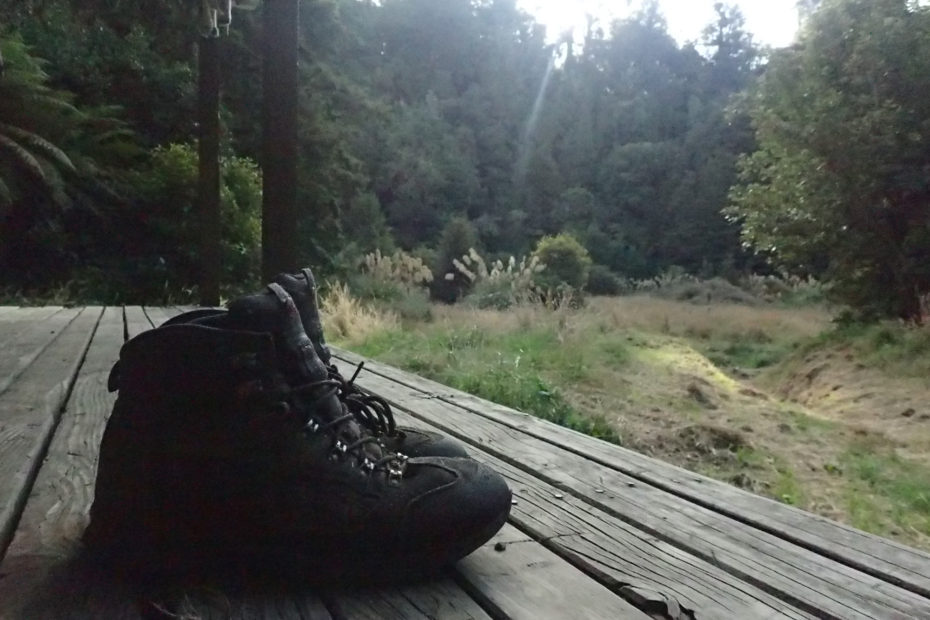
The view from Central Hut.
As the firelight died the forest seemed very black and dense around us, and it suddenly felt lonely being the only humans around for miles. Even this was a best-case scenario, assuming no psychopaths wandering the trails at night. Again, I regretted watching Making A Murderer. We didn’t have a phone, or any emergency locator device (probably an oversight), making me feel even more isolated. I felt unsettled. I loved being immersed in nature, but in the night my childhood fear of the dark, which rarely troubled me in the city, came out from somewhere in the depths of my brain. In a way, it was an innately human response – we have evolved to be enveloped in the safety of our community. In modern times we may live on our own, separated by the artifice of walls, but we still crave the comforting proximity to our neighbours.
Tonight we were like the Whio. Just the two of us, alone in the world. As we nestled into our sleeping bags, I heard their calls from the river, the thin whistle carried high on the wind. Here I was worried about the infinitesimally small chance of being attacked by a deranged chainsaw-wielding killer, when, in the absence of predator control, the female blue ducks actually stood a 46% chance of being killed and had a 90% chance of their nests being destroyed. Things were looking up for them with all the stoat traps here, but it still seemed like I stood a better chance of surviving the night than them.
For the next day and night, we saw no one else. We talked sometimes, and sometimes we just walked in silence. It was very, very quiet. As a child, I remember my homesick Australian parents saying the forest was too quiet here. They missed the colours and sound of the Australian bush – the thump of a wallaby through the scrub, or the slither of a snake across the path. The shock of pink wildflowers against the grey-green bush. In the land of the long white cloud, most flowers are small, simple and white, as New Zealand lacks the specialised flower pollinators like long-tongued bees, butterflies and hummingbirds that encouraged the evolution of complex flowers on other land masses. Instead of flashy colours, the flowers here have cultivated strong perfumes to attract native bees, night-flying moths, flies and beetles.
And maybe the absence of our furry mammalian kind (except for bats and feral invaders) disquieted us too, speaking of a past before colonisation, before Maori people and before those that came before them, in which humans were not present, and not missed. Of a time, more than 120 million years ago, when this land of the long white cloud still sat in the Antarctic circle (which was warmer then – cool but not cold), blanketed in forest and plunged into complete darkness for three months of the year. Maybe, the forest whispered, there was a time still to come, when humans would once again be absent from this Earth?
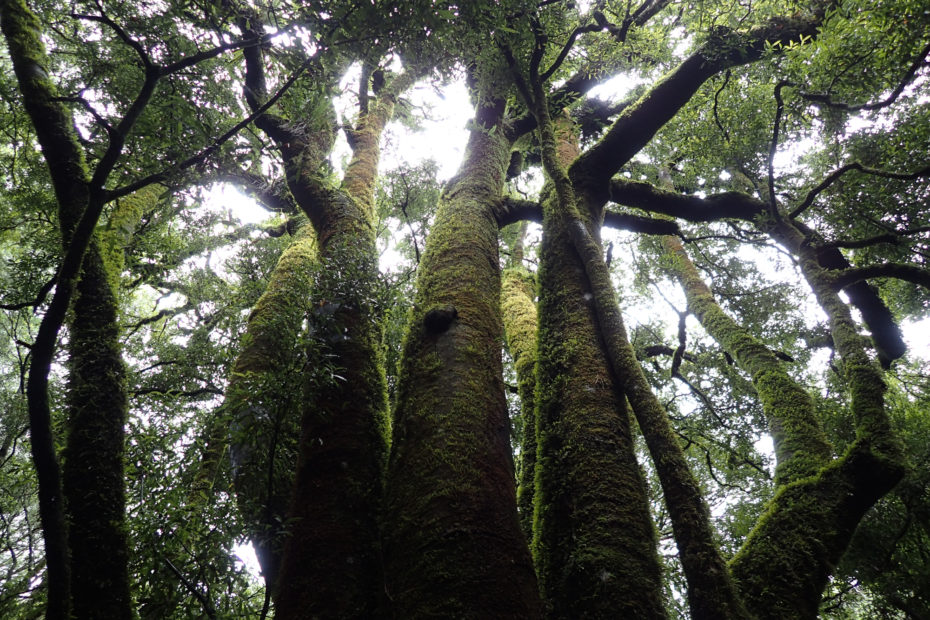
Inside the podocarp forest.
But in truth, the ringing silence of these forests was unnatural. Once, the calls of birds would have filled these empty spaces. Not so long ago, life abounded here. It was the very absence of sophisticated competitors and predators in New Zealand that allowed primitive life-forms to flourish. Without mammals monopolising the whole scene, birds, bats and insects expanded into these unfilled ecological roles. Kiwi birds came to nest in burrows like mammals do in other countries. Without small mammal predators like rats and mice, ground-walking bats, large carnivorous snails, flightless wrens and giant weta evolved to feed on insects and plants on the forest floor. Giant Moa birds, now gone forever, fed in forests and grasslands like large herbivores do in other places, becoming very large in order to digest the coarse vegetation.
Now, of course, everything has changed. The moas are gone, and an assortment of feral rodents, weasels and possums gorge themselves nightly on evolutionarily unique and helpless snails and wetas. They decimate the birds who literally put all their eggs into the ground-nesting basket, in a chilling demonstration of how natural selection can really turn the tables on you.
In response, a globally-unprecedented war on predators is now being scaled-up by the New Zealand Government. They have announced they will make the nation predator free by 2050, using a tool chest of traps, baits and poisons. 100 offshore islands have already been declared predator free. Maybe this island nation is small and isolated enough to succeed at this crazy task, where others have thrown their hands up in despair? At least here in the Whirinaki Forest, the predator-control already seemed to be working because the blue ducks, which are so rarely spotted in much of New Zealand, were not just surviving, but were abundant.
Conservation is not for soft-hearted animal-lovers in New Zealand. How many stoats is a blue duck worth? How many little necks should be snapped so that the Whio can sleep soundly at night? I don’t know. All I know is that as we walked alongside the Whirinaki River, the Whio seemed to fit within this land like a key to a lock. Somehow they had been carried out of Gondwana Land and forged by this place, with the improbability of a miracle. I didn’t want them to be gone from here. To fade from the evolutionary tree after all these twists and turns of natural selection. I didn’t want to imagine this place without their call, yet another lost song never again to ring out in these forests.
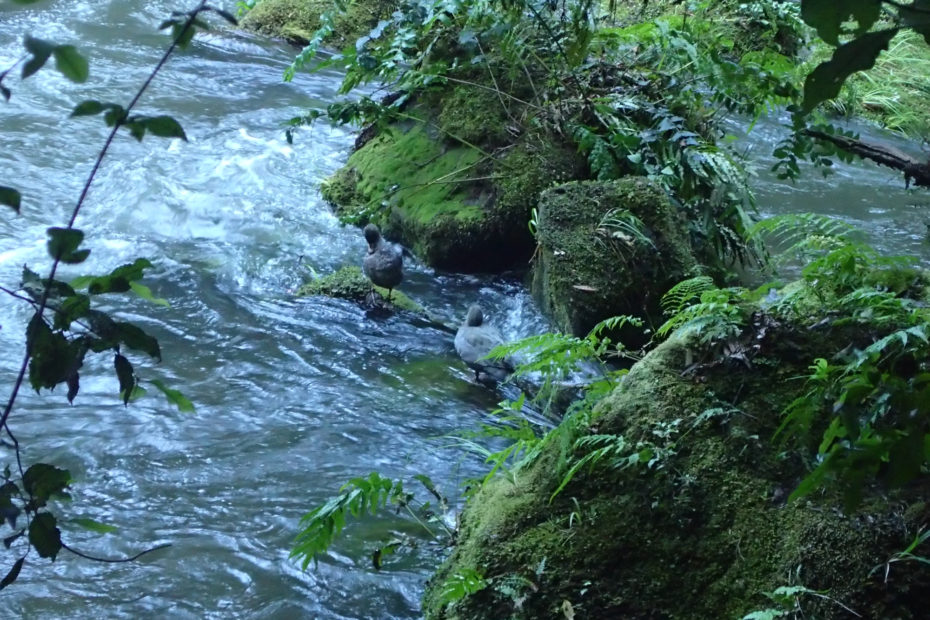
The Blue Duck/Whio on the river.

